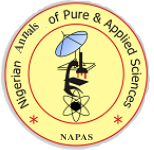Parasitic Load on Musca Domestica (Dipthera: Muscidae) From Different Synanthropic Environments in Jos Metropolis, Plateau State, Nigeria
Keywords:
Houseflies, Protozoa, Helminthes and TransmittersAbstract
This study was carried out from five (5) different sampling sites in Jos North Local Government Area of Plateau state, Nigeria during the wet season (May to July, 2016). Five hundred houseflies were captured in the different synanthropic sites in the study area. Six different parasite species were isolated from both the external body surfaces and the gut of the houseflies. These include the four nucleated cysts of Entamoeba histolytica; ova/eggs of Taenia species, Ascaris lumbricoides, Trichuris trichiura and Hookworm, and also the larvae of Strongyloides stercoralis. Open defecation site (Tudun Wada) had the highest parasite prevalence of 13(39.39%) and 8(42.11%) for both external body and gut parasitic load respectively while the lowest prevalence of 2 (6.06%) and 1(5.06) were observed in Terminus market for external body and gut parasitic loads respectively. E. histolytica had the highest prevalence of 15(45.45%) and 7 (36.84%) for external and gut parasites respectively while Hookworm and T. trichiura had the lowest prevalence of 1(3.03%) each. S.stercoralis, A. lumbricoides and E. histolytica were the only parasites found in the digestive tracts of the flies. There was no association (p>0.05) between occurrence of the different parasites and sample sites in neither the external nor endo parasites. Likewise, there was no significant difference (p>0.05) in occurrence of parasites in relation to the different body parts. This confirms that houseflies are mechanical carriers and possible transmitters of disease pathogens to man in this locality due to the intimacy shared between these Dipterans and Man. Hence, there is the need for improved sanitation and proper health awareness in Jos metropolis to avert possible disease outbreaks and epidemics associated with poor sanitary conditions
References
Abbas, N., H.A., Khan and Shad,S.A.(2014). Cross-resistance to fibronil in the housefly,Musca domestica
(Diptera:Muscidae) A potential vector for disease transmission. Parasitological Research, 113: 1343-52.
Akinboade O.A.,Hassan, J. O. and Adejinmi, A.(1984). Public Health importance of market meat exposed to refuse flies and airborne microorganisms. International Journal of Zoonoses, 11: 111-114
Balla, H.J., Usman, Y., and Muhammed, A. (2014). The role of housefly (Musca domestica) in mechanical transmission of intestinal parasites in Maiduguri metropolis, North -eastern Nigeria. Journal of Natural Sciences Research, 4(8): 60-65.
Bundy, D.A.P., Hall, A., Medley, G.F. and Savioli, L. (1992). Evaluation measures to control intestinal parasitic infections. World Health Status Quo, 45:168-79.
Che-Ghani, B.M., Oothuman, P., Hashim, B.B. and Rusli, B.I. (1993). Patterns of hookworm infections in traditional Malayan villages with and without JOICFP Integrated Project in Peninsular Malaysia-1989. Collected papers on the control of soil-transmitted helminthiases, Vol. V. APCO, Tokyo. Pp. 14-21.
El-Sherbini, G. T. and El-Sherbini, E.T. (2011). The Role of Cockroaches and flies in mechanical transmission of medical important parasites. Journal of Entomology and Nematology, 3(7):98-104. Fotedar, R., Banierjec, U., Sing, S., Shriniwas, M., and Verma, A. K. (1992). The housefly, (Musca domestica), as a carrier of pathogenic microorganisms in a hospital environment. Journal of
hospital infections, 20: 209-215.
Gehad T. and El-Sherbini.(2010). The role of cockroaches and flies in mechanical transmission of medical important parasites in Khaldiya village, Elfayoum, Governorate, Egypt. http:// ww w.ar ticl esba se.c om/h ealt harticles/therole-of-cockroach-andflies-intransmission-of-medicalimportant-parasites-in-khaldiyavillage-el-fayoum-governorate-egypt300840html
Getachew, S., Gebre – Micheal, T.S., Erko, B., Balkew, M. and Medhin, G. (2007). Non – biting cyclorrhaphan flies (Diptera) as carriers of intestinal human parasites in slum areas of Addis Ababa, Ethiopia. Acta Tropica, 103:186 – 194.
Graczyk, T. K., M.R. Granfield, R. Fayer and H. Bixter (1991). Houseflies as transport hosts of intestinal parasites. Journal of Medical Hygiene, 61:500-504.
Graczyk, T. K., M.R. Granfield, R. Fayer and H. Bixter. (1999). House flies (Muscadomestica) as transport host of Cryptosporidium parvum. American Journal of Tropical Medicine and Hygiene, 61:500 – 4.
Graczyk, T. K; Knight, R. And Tarnang., L. (2005). Mechanical transmission of human protozoan parasites by insects. Clinical Microbiology Reviews, 18 (1): 128 – 32.
Keidjing J. (1986). The housefly- biology and control (advanced level). Geneva World Health Organisation, (unpublished document) WHO/ VBC/86.937).302-323.
Malik A.,Singh N., And Satya S.(2007). Housefly (Musca domestica): A review of control strategies for a challenging pest. Journal of Environmental Sciences and Health, 42:453-469.
Maipanich, w., Yoonuan, T., Thaenkam, U., Komalamisra, C., Singhasivanori, P., and Adams, P.R. (2012). Houseflies: A possible transport host of Angiostrongylus sp. Journal of Tropical Medicine and Parasitology,35(1):22-26.
Mawak, J.D, and Olukose, O.J (2006). Vector potentials of Houseflies (Musca domectica) for pathogenic organisms in Jos, Nigeria. Journal of Pest, Disease and Vector Management, 7:418 – 423.
Mott, K.E. (1989). The World Health Organization and the control of intestinal helminths. Collected papers on the control of soil-transmitted helminthiases, Vol. IV. Tokyo: APCO. Pp. 189-200.
Mullen, G. H. and Durben, L. A. (2002). Medical and Veterinary Entomology. Academic Press, New York.
Nwangwu, U.C., Omyido, A.E., Egbuche, C.M., Iwueze, M.O. and EzugboNwobi, I.K. (2013). Parasites
associated with wild-caught houseflies in Awka metropolis. Journal of Pharmacy and Biological Sciences,
(1):12-19.
Oghale, O.O., Ebube, C.A., and Oluchi, U.O. (2013). Parasitic load on Musca domestica (Dipthera:Muscidae) from different synanthropic environments in Umuahia metropolis. Journal of
Public Health and Epidemiology, 5(8): 309-312.
Ogunnyi, A.B.T., Olajide, S.J., and Oyelade, O.J. (2015). Human intestinal parasites associated with non-biting flies in IleIfe, Nigeria. Journal of medical and Biological Science Research, 1(9): 124-129.
Olsen, A. R. (1998). Regulatory action criteria for filth flies and extraneous materials: Review of flies and
food borne enteric diseases. Reg. Parasitol., 4:22-27
Ugbogu, O.C., Nwachukwu, N.C and Ogbuagu M.N. (2006) Isolation of Salmonella and Shigella species from house flies (Musca domestica L.) in Utru, Nigeria. African Journal of Biotechnology, 5: 1090 – 1091.
Umeche, N. and Mandah, L.E. (1989) Musca domestica as a carrier of intestinal helminthes in Calabar, Nigeria. East African Medical Journal, 66: 349-352.
World Health Organisation (2012s). Bench aids for the diagnosis of intestinal Parasites. ISBN 97892, 1544764(NLM Classification). Pp. 3-23
Downloads
Published
How to Cite
Issue
Section
License
Copyright (c) 2023 C. M. Adeiyongo, Dakul D. A., Lawan, S. B., Achoru, V. C

This work is licensed under a Creative Commons Attribution-ShareAlike 4.0 International License.



 Contact Us
Contact Us Editorial Team
Editorial Team Join As A Reviewer
Join As A Reviewer  Request For Print Copy
Request For Print Copy


 Cprint Publishers
Cprint Publishers